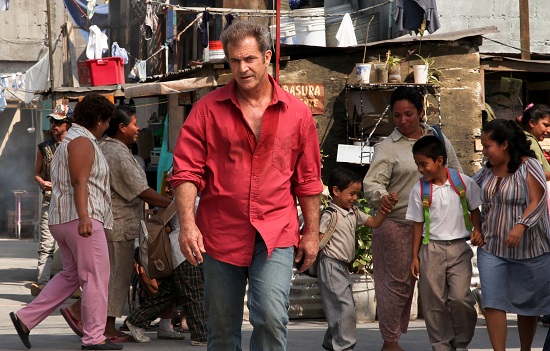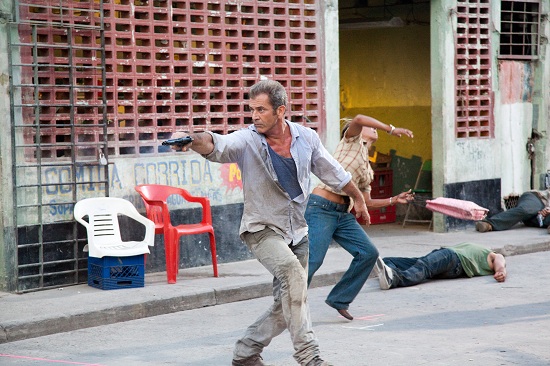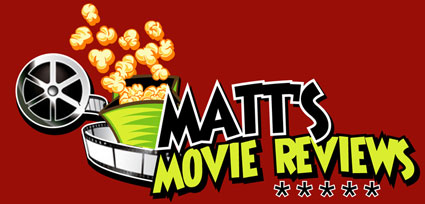Mel Gibson’s film career has taken a knock of late, yet his latest film Get the Gringo promises to put Gibbo back on track.
The film also introduces a new talent behind the lens is Adrian Grunberg. Raised in Spain by his Argentine Jewish parents before moving to Mexico (which he has called home for the last 15 years), Grunberg has made a prolific career as an assistant director to some of the worlds most acclaimed filmmakers, including Gibson himself on the 2006 Mayan set thriller Apocalypto.
Get the Gringo stars Gibson as an unnamed career criminal who finds himself in a Mexican prison after literally crashing into the border with millions of stolen drug dollars in his banged up car. Stuck in a world of violence and corruption, he has to figure out how to survive long enough to escape his confines and get his money back from corrupt officials.
Matt’s Movie Reviews spoke to Grunberg about making Get the Gringo, working with Mel Gibson, and his future as a filmmaker in an increasingly changing industry.
Enjoy!
When were you first approached to direct Get the Gringo?
It was shortly after Apocalypto came out. I was visiting Mel at his office and he said he had this idea for a movie and he wanted to direct it. I said “Oh! That’s great. That’s awesome.” I didn’t give it too much thought until a few months later he called me and said, “Ok. We should start getting together and start throwing ideas.”
He had this idea about an American citizen ending up in a Mexican prison, so we started throwing ideas around and then through researching and writing, eventually this is what came out.
The Mexican prison environment in the film is very different to anything I’ve ever seen. It was influenced by the El Pueblito prison which was pretty much a shanty town. When did you first hear about this place?
Well, when we started discussing about the movie and what the movie was about, I started researching prisons all over the world, really, basically in third world countries and just reading about them.
I had never heard of El Pueblito and I stumbled across an article, then I started researching El Pueblito and I said “this is it. This is our prison.”
Get the Gringo is the first time you get to call the shots. What part of the job surprised you the most?
I was pleasantly surprised all around. I’ve been around long enough to understand what it was about. I’ve always wanted to direct so I felt it was a natural move and I enjoyed the shit out of it (laughs).
Have you found that you developed your own style of directing? Or will your own style come to you as you direct more?
I think both. I know for a fact I still have a lot to learn and a lot to work with. Moulding a style…. You know, I don’t think the style came throughout the movie. I think a lot of me is in there, but I also think there is a lot yet to come.
 |
"There is a lot I learned from Mel during Apocalypto especially, and he was actually really good at allowing me to do my thing, so I was always in that comfort zone with him." - Adrian Grunberg |
You’ve had a lot of practical training. You were an assistant director for many great filmmakers. What does it take to have such trust placed in your abilities by filmmakers as revered as Peter Weir and Steven Soderbergh?
Work ethic. I think primarily for me there is a work ethic and what helped me a lot is not coming up in the Hollywood system. My professional career was done 100% in Mexico and it gave me the ability, whether it was a Mexican film or a foreign film, to be much more involved than if I had done my career in Hollywood.
I had more liberty, I had more freedom and I had the possibility of doing more than maybe I was expected to because I was helping people who don’t speak the language direct Mexican actors and Mexican extras who don’t speak English.
So I thought that I was able to gain that trust because I was able to read what they wanted and give it to them.
With Get the Gringo you were placed in an interesting situation where in your debut you were directing an Oscar winning director. Were there any specific challenges that came from that situation?
Look I’m sure there are, but I didn’t live them because I didn’t come into this project as a work for hire. I wasn’t called with “look, there is this script and Mel wants you to direct it.” I had known Mel for a number of years, we had worked together on a number of occasions and we wrote it together.
So I was sort of in the comfort zone from the beginning. There is a lot I learned from Mel during Apocalypto especially, and he was actually really good at allowing me to do my thing, so I was always in that comfort zone with him.
It seems to me that Mel was something of a mentor to you in your progression as a director. Were there any other directors that you worked with that were also very influential in the way you approached directing?
Obviously! I’ve had the luxury of working with many talented people that I’ve admired for many years, and it’s interesting to see how different people work and that’s probably something that I’m always able to get more than other directors because I worked with a bunch of them.
Oliver Stone, Jim Jarmusch…those are guys that I liked way before I was in the business, so it was a pleasure and it was great to be able to work with people in different sizes of movies and different methods.
When Mel Gibson returned to acting a few years on Edge of Darkness he said the reason he stayed away from acting was that the process got boring for him, so he opted for more directing projects. Now that he’s back at acting what is his attitude to the craft these days? Is there anything he does with acting now that he didn’t do before?
I don’t think so. He hasn’t said anything in particular. I think the approach is the same. He’s older and wiser now, so he probably has to understand who he is now years later, but he’s got this unnatural ability to let that show on screen. He doesn’t have to do much to do a lot.
 |
"I go to the movies to be entertained, whether they make you think or not. Where it takes you varies on the film. But at the end of the day it’s 2 hours of leaving my reality and going into someone else’s reality. If that is a violent reality then so be it." - Adrian Grunberg |
Get the Gringo releases in VOD in America. It is a distribution model that has become increasingly popular. Can you foresee a time where movies streamed to TV or a computer will become more popular than movies played at a cinema?
I think we’re… I don’t know how old you are but we’ll live to see that. It’s right around the corner. It’s a popular model. For example…basically the rest of the world is not doing that because their market is not that big. The on demand market outside of the U.S. cannot generate the amount of money it can in the states.
As an example in Mexico, which is where I live, it has to go theatrical everywhere else to make money and the only place where you can actually do this at this point is the U.S. But it’s the future and it won’t be long until it’s beamed directly to your iPhone.
What do you think that type of distribution will do to the craft of cinema? People will be watching movies on smaller screens compared, of course, to a cinema screen. Do you think you as a director will have to change the way you approach directing a film in regards to these formats?
I think what will change definitely as a model is the amount of money spent. You will always have the Harry Potter’s and the Avatar’s and the Dark Knight’s…I pray to God we will always have those! (laughs) Because the experience of going to the movies and seeing one of those movies or 3D movies can’t be beat.
But it’s too costly as a business model and those are what? 10 movies a year? The rest of us that, you know, are not doing The Dark Knight are open to a lot of possibilities. With the digital format everybody can be a director now, which is great!
Get the Gringo can be a violent film, and the majority of the time the violence is played for entertainment value. What is your philosophy to violence on film?
Look, if it serves the story…I go to the movies to be entertained, whether they make you think or not. Where it takes you varies on the film. But at the end of the day it’s 2 hours of leaving my reality and going into someone else’s reality. If that is a violent reality then so be it.
I was asked at some point “Why did we decide to make this an R-rated movie?” Well we didn’t decide anything. The movie grew into that because you can’t do a movie in a prison with no foul language.
So I think the story dictates the amount of violence and I think that is the case with Get the Gringo.
You’ve lived in Mexico for the past 15 years. What is the filmmaking industry like there and are you planning to set more films in Mexico?
I’m an adopted son of Mexico. I love this country and my professional career was done here. It’s a vibrant country with a lot of talent and I have learned a lot working within the Mexican crews and the Mexican system. Will I do more movies here? I have no idea. But I think write off the bat I wouldn’t, just because I wouldn’t be pinned as a Mexican director. But if I’m attracted to something here again, yeah I won’t close the door to it.
|
